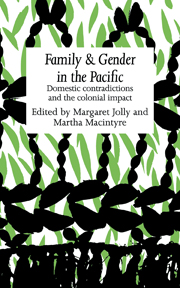Book contents
- Frontmatter
- Contents
- List of contributors
- Acknowledgements
- Map of main island groups of the Pacific
- Map of Papua New Guinea – Provinces
- Introduction
- 1 New England missionary wives, Hawaiian women and ‘The Cult of True Womanhood’
- 2 Changes in the lives of ordinary women in early post-contact Hawaii
- 3 Domestic structures and polyandry in the Marquesas Islands
- 4 The object lesson of a civilised, Christian home
- 5 Medical care and gender in Papua New Guinea
- 6 Suffer the children: Wesleyans in the D'Entrecasteaux
- 7 Women in contemporary Central Enga society, Papua New Guinea
- 8 Better homes and gardens
- 9 God, ghosts and people: Christianity and social organisation among Takuru Wiru
- 10 Sins of a mission: Christian life as Kwaio traditionalist ideology
- 11 Sacred spaces: churches, men's houses and households in South Pentecost, Vanuatu
- 12 Bond-slaves of Satan: Aboriginal women and the missionary dilemma
- Bibliography
- Index
4 - The object lesson of a civilised, Christian home
Published online by Cambridge University Press: 05 November 2011
- Frontmatter
- Contents
- List of contributors
- Acknowledgements
- Map of main island groups of the Pacific
- Map of Papua New Guinea – Provinces
- Introduction
- 1 New England missionary wives, Hawaiian women and ‘The Cult of True Womanhood’
- 2 Changes in the lives of ordinary women in early post-contact Hawaii
- 3 Domestic structures and polyandry in the Marquesas Islands
- 4 The object lesson of a civilised, Christian home
- 5 Medical care and gender in Papua New Guinea
- 6 Suffer the children: Wesleyans in the D'Entrecasteaux
- 7 Women in contemporary Central Enga society, Papua New Guinea
- 8 Better homes and gardens
- 9 God, ghosts and people: Christianity and social organisation among Takuru Wiru
- 10 Sins of a mission: Christian life as Kwaio traditionalist ideology
- 11 Sacred spaces: churches, men's houses and households in South Pentecost, Vanuatu
- 12 Bond-slaves of Satan: Aboriginal women and the missionary dilemma
- Bibliography
- Index
Summary
Missionaries were major agents of change in the Pacific region during the nineteenth and early twentieth centuries. They were arguably more effective as such than any other foreign agents of the time due to their numerical strength, their dispersal, their tenacity, their learning of the local languages, and hence their ability to communicate, but above all, to their commitment to effecting change – a metanoia, as Burridge defines it (1975:10) – in the lives of the people with whom they interacted. This change was primarily a change in the hearts and souls of converts, but an inevitable corollary was a change, to a greater or lesser extent, in their social organisation and cultural activities.
Despite a popular image which sees missionaries as unremittingly and uncritically iconoclastic, they in fact varied considerably in the extent and types of change which they required as evidence of conversion. In this chapter I will discuss some of the changes in family life and related aspects of social organisation imposed by missionaries of the four organisations operating in Papua before the World War I – the Roman Catholic Sacred Heart Mission (SHM), the predominantly Anglo-Catholic Anglican Mission, the Australasian Wesleyan Methodist Mission and the London Missionary Society (LMS), comprised largely of British Congregationalists – and later suggest some explanations as to variation in expectations, not only among the four missionary bodies but even, within the constraints of mission organisation, among the personnel of a single mission.
- Type
- Chapter
- Information
- Family and Gender in the PacificDomestic Contradictions and the Colonial Impact, pp. 84 - 94Publisher: Cambridge University PressPrint publication year: 1989
- 10
- Cited by

